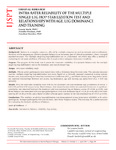INTRA-RATER RELIABILITY OF THE MULTIPLE SINGLE-LEG HOP-STABILIZATION TEST AND RELATIONSHIPS WITH AGE, LEG DOMINANCE AND TRAINING.
| dc.contributor.author | Sawle, L | |
| dc.contributor.author | Freeman, J | |
| dc.contributor.author | Marsden, J | |
| dc.date.accessioned | 2017-05-30T09:12:52Z | |
| dc.date.available | 2017-05-30T09:12:52Z | |
| dc.date.issued | 2017-04 | |
| dc.identifier.issn | 2159-2896 | |
| dc.identifier.issn | 2159-2896 | |
| dc.identifier.uri | http://hdl.handle.net/10026.1/9381 | |
| dc.description.abstract |
BACKGROUND: Balance is a complex construct, affected by multiple components such as strength and co-ordination. However, whilst assessing an athlete's dynamic balance is an important part of clinical examination, there is no gold standard measure. The multiple single-leg hop-stabilization test is a functional test which may offer a method of evaluating the dynamic attributes of balance, but it needs to show adequate intra-tester reliability. PURPOSE: The purpose of this study was to assess the intra-rater reliability of a dynamic balance test, the multiple single-leg hop-stabilization test on the dominant and non-dominant legs. DESIGN: Intra-rater reliability study. METHODS: Fifteen active participants were tested twice with a 10-minute break between tests. The outcome measure was the multiple single-leg hop-stabilization test score, based on a clinically assessed numerical scoring system. Results were analysed using an Intraclass Correlations Coefficient (ICC2,1) and Bland-Altman plots. Regression analyses explored relationships between test scores, leg dominance, age and training (an alpha level of p = 0.05 was selected). RESULTS: ICCs for intra-rater reliability were 0.85 for the dominant and non-dominant legs (confidence intervals = 0.62-0.95 and 0.61-0.95 respectively). Bland-Altman plots showed scores within two standard deviations. A significant correlation was observed between the dominant and non-dominant leg on balance scores (R(2)=0.49, p<0.05), and better balance was associated with younger participants in their non-dominant leg (R(2)=0.28, p<0.05) and their dominant leg (R(2)=0.39, p<0.05), and a higher number of hours spent training for the non-dominant leg R(2)=0.37, p<0.05). CONCLUSIONS: The multiple single-leg hop-stabilisation test demonstrated strong intra-tester reliability with active participants. Younger participants who trained more, have better balance scores. This test may be a useful measure for evaluating the dynamic attributes of balance. LEVEL OF EVIDENCE: 3. | |
| dc.format.extent | 190-198 | |
| dc.format.medium | ||
| dc.language | eng | |
| dc.language.iso | en | |
| dc.subject | Assessment | |
| dc.subject | balance | |
| dc.subject | hop testing | |
| dc.subject | reliability | |
| dc.title | INTRA-RATER RELIABILITY OF THE MULTIPLE SINGLE-LEG HOP-STABILIZATION TEST AND RELATIONSHIPS WITH AGE, LEG DOMINANCE AND TRAINING. | |
| dc.type | journal-article | |
| dc.type | Article | |
| plymouth.author-url | https://www.ncbi.nlm.nih.gov/pubmed/28515973 | |
| plymouth.issue | 2 | |
| plymouth.volume | 12 | |
| plymouth.publication-status | Published | |
| plymouth.journal | International Journal of Sports Physical Therapy | |
| plymouth.organisational-group | /Plymouth | |
| plymouth.organisational-group | /Plymouth/Faculty of Health | |
| plymouth.organisational-group | /Plymouth/Faculty of Health/School of Health Professions | |
| plymouth.organisational-group | /Plymouth/REF 2021 Researchers by UoA | |
| plymouth.organisational-group | /Plymouth/REF 2021 Researchers by UoA/UoA03 Allied Health Professions, Dentistry, Nursing and Pharmacy | |
| plymouth.organisational-group | /Plymouth/Research Groups | |
| plymouth.organisational-group | /Plymouth/Research Groups/FoH - Applied Parkinson's Research | |
| plymouth.organisational-group | /Plymouth/Research Groups/Institute of Health and Community | |
| plymouth.organisational-group | /Plymouth/Research Groups/Plymouth Institute of Health and Care Research (PIHR) | |
| plymouth.organisational-group | /Plymouth/Users by role | |
| plymouth.organisational-group | /Plymouth/Users by role/Academics | |
| plymouth.organisational-group | /Plymouth/Users by role/Researchers in ResearchFish submission | |
| dc.publisher.place | United States | |
| dcterms.dateAccepted | 2017-03-07 | |
| dc.identifier.eissn | 2159-2896 | |
| dc.rights.embargoperiod | Not known | |
| rioxxterms.licenseref.uri | http://www.rioxx.net/licenses/all-rights-reserved | |
| rioxxterms.licenseref.startdate | 2017-04 | |
| rioxxterms.type | Journal Article/Review |


